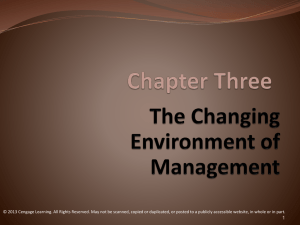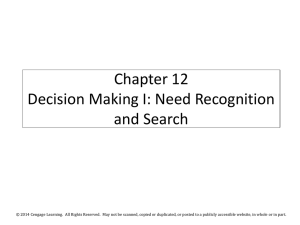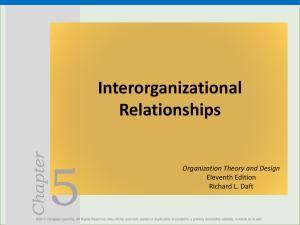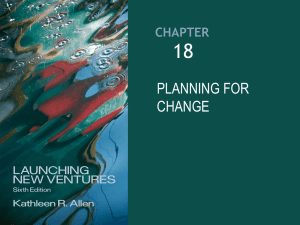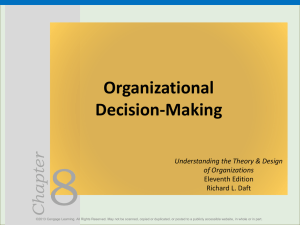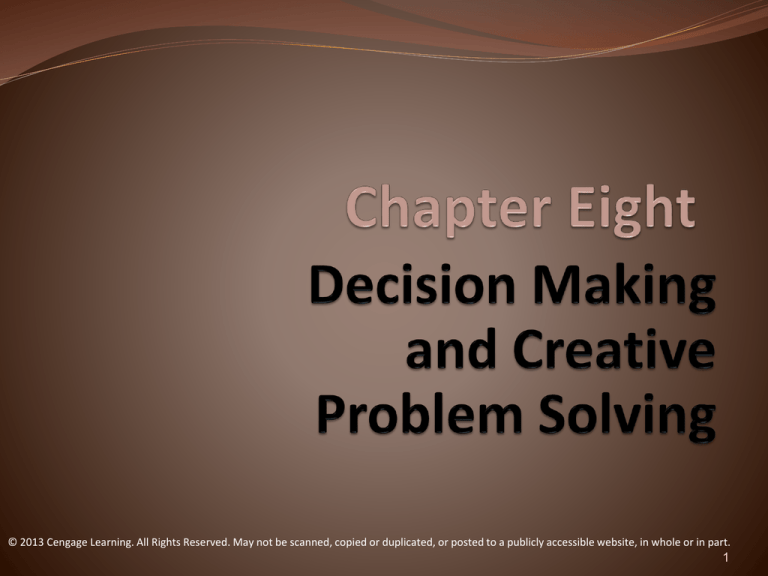
© 2013 Cengage Learning. All Rights Reserved. May not be scanned, copied or duplicated, or posted to a publicly accessible website, in whole or in part.
1
Chapter Objectives
Specify at least five sources of decision complexity for modern managers.
Explain what a condition of risk is and what managers can do to cope with it.
Define and discuss the three decision traps: framing, escalation of
commitment, and overconfidence.
Discuss why programmed and nonprogrammed decisions require different
decision-making procedures and distinguish between the two types of
knowledge in knowledge management.
Explain the need for a contingency approach to group-aided decision making.
Identify and describe five of the ten “mental locks” that can inhibit creativity.
List and explain the four basic steps in the creative problem-solving process.
Describe how causes of problems can be tracked down with fishbone diagrams.
© 2013 Cengage Learning. All Rights Reserved. May not be scanned, copied or duplicated, or posted to a publicly accessible website, in whole or in part.
2
Challenges for Decision Makers
Decision Making
The process of identifying and choosing alternative
courses of action to meet the demands of a situation.
Alternative courses of action must be identified,
weighed, and weeded out.
Trends in Decision Making
The complexity of decision-making has accelerated.
© 2013 Cengage Learning. All Rights Reserved. May not be scanned, copied or duplicated, or posted to a publicly accessible website, in whole or in part.
3
Challenges for Decision Makers
(cont’d)
Dealing with Complex Streams of Decisions
Multiple criteria to be satisfied by a decision
Intangibles that often determine decision alternatives
Risk and uncertainty about decision alternatives
Long-term implications of the effects of the choice of a particular alternative
Interdisciplinary input, which increases the number of persons to be consulted
before a decision is made
Pooled decision making increases the number of persons playing a part in the
decision process.
Value judgments by differing participants in the process create disagreement over
whether a decision is right or wrong, good or bad, and ethical or unethical.
Unintended consequences occur because the results of purposeful actions cannot
always be predicted.
© 2013 Cengage Learning. All Rights Reserved. May not be scanned, copied or duplicated, or posted to a publicly accessible website, in whole or in part.
4
Coping with Uncertainty
Types (Conditions) of Uncertainty
Certainty: Exists when a solid factual basis allows
prediction of a decision’s outcome
Risk: Exists when a decision is made on the basis of
incomplete but reliable information
Objective probabilities are based on reliable data.
Subjective probabilities are based on judgment.
Uncertainty: Exists when no reliable data exist on
which to base a decision
© 2013 Cengage Learning. All Rights Reserved. May not be scanned, copied or duplicated, or posted to a publicly accessible website, in whole or in part.
5
Information Processing Styles
Thinking Style
Being deliberative, logical, precise, and objective when
making a decision
Suited to routine tasks requiring attention to detail and
systematic implementation
Intuitive Style
Being creative, following hunches and visions in
decision making
Best for rapidly changing situations requiring creativity and
intuition
© 2013 Cengage Learning. All Rights Reserved. May not be scanned, copied or duplicated, or posted to a publicly accessible website, in whole or in part.
6
Avoiding Perceptual
and Behavioral Decision Traps
Framing Error
The way in which information is presented influences
one’s interpretation of it, which, in turn, may alter a
decision based on the information.
Escalation of Commitment
Continuing on a course of action can lock a person into
a losing position (“throwing good money after bad”).
Overconfidence
Believing too much in one’s own capabilities is a trap.
© 2013 Cengage Learning. All Rights Reserved. May not be scanned, copied or duplicated, or posted to a publicly accessible website, in whole or in part.
7
A General Decision-Making Model
Rational (Logical) Decision Model Steps
Scan the situation; identify a signal that a decision
should be made.
Receipt of authoritative communications from superiors
Cases referred for decision by subordinates
Cases originating from the manager
Classify the decision. If it is routine, apply the
appropriate decision rule; if it is not, generate a
nonprogrammed decision through problem solving.
Monitor and follow-up as necessary.
© 2013 Cengage Learning. All Rights Reserved. May not be scanned, copied or duplicated, or posted to a publicly accessible website, in whole or in part.
8
A General Decision-Making Model
(cont’d)
Knowledge Management
Developing a system to improve the creation and
sharing of knowledge critical for decision making
Tacit knowledge: Personal, intuitive, and
undocumented private information
Explicit knowledge: Readily sharable public
information in verbal, textual, visual, or numerical
form
© 2013 Cengage Learning. All Rights Reserved. May not be scanned, copied or duplicated, or posted to a publicly accessible website, in whole or in part.
9
Figure 8.5: Key Dimensions of
Knowledge Management (KM)
© 2013 Cengage Learning. All Rights Reserved. May not be scanned, copied or duplicated, or posted to a publicly accessible website, in whole or in part.
10
A General Decision-Making Model
(cont’d)
Improving the Flow of Knowledge
The flow of constructive tacit knowledge between
coworkers is a priority.
KM software is proving very useful and cost-effective in
large organizations for sharing both tacit and explicit
knowledge
Knowing what you know, what you don’t know, and
how to find what you know yields better and more
timely decisions.
© 2013 Cengage Learning. All Rights Reserved. May not be scanned, copied or duplicated, or posted to a publicly accessible website, in whole or in part.
11
A General Decision-Making Model
(cont’d)
Improving the Flow of Knowledge
Organization cultures
Participative management
Training
Virtual teams
Communication
Transformational
Empowerment
leadership
Mentoring
© 2013 Cengage Learning. All Rights Reserved. May not be scanned, copied or duplicated, or posted to a publicly accessible website, in whole or in part.
12
Group-Aided Decision Making:
A Contingency Perspective
Collaborative Computing
Teaming up to make decisions via a computer network
programmed with groupware
Group Involvement in Decisions
Analyzing the problem
Identifying components of the situation
Estimating components of the situation
Designing alternatives
Choosing an alternative
© 2013 Cengage Learning. All Rights Reserved. May not be scanned, copied or duplicated, or posted to a publicly accessible website, in whole or in part.
13
Group-Aided Decision Making:
A Contingency Perspective
(cont’d)
The Problem of Dispersed Accountability
Group-aided decision making: The group does
everything except make the decision.
Group decision making: The group actually makes the
final decision collectively.
Results in loss of personal/individual accountability
Individual accountability is required when:
The decision will have significant organizational impact.
The decision has legal ramifications.
A competitive reward is tied to the decision.
© 2013 Cengage Learning. All Rights Reserved. May not be scanned, copied or duplicated, or posted to a publicly accessible website, in whole or in part.
14
A Contingency Approach Is Necessary
Individuals Versus Groups
Groups do better quantitatively and qualitatively than
the average individual.
Exceptional individuals tend to outperform the group.
Group decision-making performance does not always
exceed individual performance, making a contingency
approach to decision making advisable.
© 2013 Cengage Learning. All Rights Reserved. May not be scanned, copied or duplicated, or posted to a publicly accessible website, in whole or in part.
15
Figure 8.6: The
ProblemSolving Process
© 2013 Cengage Learning. All Rights Reserved. May not be scanned, copied or duplicated, or posted to a publicly accessible website, in whole or in part.
16
Managerial Creativity
What Is Creativity?
The reorganization of experience into new
configurations
Creativity is a function of knowledge, imagination, and
evaluation.
Three domains of creativity:
Art
Discovery
Humor
Myth: Creative people are typically nonconformists
© 2013 Cengage Learning. All Rights Reserved. May not be scanned, copied or duplicated, or posted to a publicly accessible website, in whole or in part.
17
Creative Problem Solving
Problem solving is the conscious process of bringing
the actual situation closer to the desired situation.
Steps in Creative Problem Solving
Identifying the problem
Generating alternative solutions
Selecting a solution
Implementing and evaluating the solution
© 2013 Cengage Learning. All Rights Reserved. May not be scanned, copied or duplicated, or posted to a publicly accessible website, in whole or in part.
18
Summary
Decision making is a fundamental part of management because it requires choosing
among alternative courses of action.
Managers must learn to assess the degree of certainty in a situation—whether conditions
are certain, risky, or uncertain.
Researchers have identified three perceptual and behavioral decision traps that can
undermine the quality of decisions: framing error, escalation of commitment, and
overconfidence.
Decisions, generally, are either programmed or non-programmed.
Managers may choose to bring other people into virtually every aspect of the decisionmaking process.
Creativity requires the proper combination of knowledge, imagination, and evaluation to
reorganize experience into new configurations.
The creative problem-solving process consists of four steps: (1) identifying the problem,
(2) generating alternative solutions, (3) selecting a solution, and (4) implementing and
evaluating the solution.
A clear and concise statement of the problem forms the “head” of the fishbone skeleton.
© 2013 Cengage Learning. All Rights Reserved. May not be scanned, copied or duplicated, or posted to a publicly accessible website, in whole or in part.
19
Terms to Understand
Decision making
Law of unintended
consequences
Condition of certainty
Condition of risk
Objective probabilities
Subjective probabilities
Condition of uncertainty
Framing error
Escalation of commitment
Programmed decisions
Decision rule
Knowledge management
Tacit knowledge
Explicit knowledge
Collaborative computing
Creativity
Problem solving
Problem
Causes
Satisfice
Optimize
Idealize
© 2013 Cengage Learning. All Rights Reserved. May not be scanned, copied or duplicated, or posted to a publicly accessible website, in whole or in part.
20



